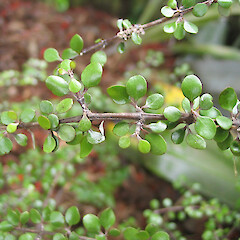Olearia polita
Synonyms
None
Family
Asteraceae
Flora category
Vascular – Native
Endemic taxon
Yes
Endemic genus
No
Endemic family
No
Structural class
Trees & Shrubs - Dicotyledons
NVS code
The National Vegetation Survey (NVS) Databank is a physical archive and electronic databank containing records of over 94,000 vegetation survey plots - including data from over 19,000 permanent plots. NVS maintains a standard set of species code abbreviations that correspond to standard scientific plant names from the Ngä Tipu o Aotearoa - New Zealand Plants database.
OLEPOL
Chromosome number
2n = 108
Current conservation status
The conservation status of all known New Zealand vascular plant taxa at the rank of species and below were reassessed in 2017 using the New Zealand Threat Classification System (NZTCS) – more information about this can be found on the NZTCS website. This report includes a statistical summary and brief notes on changes since 2012 and replaces all previous NZTCS lists for vascular plants.
Please note, threat classifications are often suggested by authors when publications fall between NZTCS assessment periods – an interim threat classification status has not been assessed by the NZTCS panel.
- Conservation status of New Zealand indigenous vascular plants, 2017 . 2018. Peter J. de Lange, Jeremy R. Rolfe, John W. Barkla, Shannel P. Courtney, Paul D. Champion, Leon R. Perrie, Sarah M. Beadel, Kerry A. Ford, Ilse Breitwieser, Ines Schönberger, Rowan Hindmarsh-Walls, Peter B. Heenan and Kate Ladley. Department of Conservation. Source: NZTCS and licensed by DOC for reuse under the Creative Commons Attribution 4.0 International licence.
2017 | Threatened – Nationally Endangered | Qualifiers: CD, RR
Previous conservation statuses
2012 | Threatened – Nationally Endangered | Qualifiers: CD, RR
2009 | Threatened – Nationally Endangered | Qualifiers: CD, RR
2004 | Threatened – Nationally Endangered
Brief description
Rare widely-branched tangled shrub with reddish twigs with two ridges bearing small glossy dark-green rounded leaves that are white underneath inhabiting damp sites in the Hope Valley. Leaves 4-12mm long by 3-6mm wide, tapering abruptly to a winged stalk. Flowers small. Seeds fluffy.
Distribution
Endemic. South Island, North West Nelson, near Wangapeka and at Glenhope.
Habitat
Lowland, riparian Silver beech (Nothofagus menziesii (Hook.f.) Oerst.) forest, where it grows in the under storey.
Wetland plant indicator status rating
Information derived from the revised national wetland plant list prepared to assist councils in delineating and monitoring wetlands (Clarkson et al., 2021 Manaaki Whenua – Landcare Research Contract Report LC3975 for Hawke’s Bay Regional Council). The national plant list categorises plants by the extent to which they are found in wetlands and not ‘drylands’. The indicator status ratings are OBL (obligate wetland), FACW (facultative wetland), FAC (facultative), FACU (facultative upland), and UPL (obligate upland). If you have suggestions for the Wetland Indicator Status Rating, please contact: [Enable JavaScript to view protected content]
FACU: Facultative Upland
Occasionally is a hydrophyte but usually occurs in uplands (non-wetlands).
Detailed description
Shrub 2-4 m tall. Branches interlacing, strongly divaricating. Bark dark red-brown maturing greyish brown. Branchlets 2-angled so forming a paired conspicuous longitudinal ridge extending along branch length. Young branchlets pubescent near tips. Internodes of long shoots 10-20(30) mm. Short shoots (brachyblasts) opposite, bearing 2-4 leaves and/or 1-5 capitula. Leaves opposite or in opposite fascicles, 4-8(-10) x 3-6(-7) mm,suborbicular, broadly obovate to spathulate, upper surface bright glossy green when fresh, glabrescent, margins red or brown, under surface coated in copious, densely appressed, short silvery white hairs, leaf apex obtuse with a minute apiculus. Petiole (0.5)1.5-3(-4) mm, reddish, narrowly winged. Juvenile leaves similar but with small denticles on leaf margins as well as apex. Capitula in clusters of (1-)2-4(-5). Florets 4-5. Achenes (seeds) 1.7-2 mm.
Similar taxa
This species is readily distinguished from other small-leaved Olearia species by the 2-angled branchlets, and bright glossy green (appearing as if polished) upper leaf surfaces. The juvenile foliage is often deeply toothed, and this is also seen on reversion shoots.
Flowering
October - November
Flower colours
Cream, Yellow
Fruiting
November to January
Propagation technique
Easily grown from fresh seed and semi hardwood cuttings. Does best in semi-shade (it is an attractive shrub to plant under taller trees, particularly deciduous species) in a moist, fertile soil. The small flowers are sweetly scented, particularly at night.
Threats
Threatened by browsing animals, weeds and the fact that most populations occur on private land. Recruitment is potentially limiting some populations.
Etymology
olearia: Named after Johann Gottfried Olearius, a 17th-century German scholar, writer of hymns and author of Specimen Florae Hallensis
polita: Smooth or polished
Where To Buy
Commercially available from some specialist native plant nurseries.
Attribution
Fact Sheet prepared for the NZPCN by P.J. de Lange 14 April 2006. Description by P.B Heenan and P.J. de Lange (adapted from Wilson & Garnock-Jones 1992) and subsequently published in de Lange et al. (2010).
References and further reading
de Lange, P.J.; Heenan, P.B.; Norton, D.A.; Rolfe, J.R.; Sawyer, J.W.D. 2010: Threatened Plants of New Zealand. Canterbury University Press, Christchurch.
Wilson, H.D.; Garnock-Jones, P. J. 1992: Two new species names in Olearia (Asteracae) from New Zealand. New Zealand Journal of Botany 30(3): 365-368
NZPCN Fact Sheet citation
Please cite as: de Lange, P.J. (Year at time of access): Olearia polita Fact Sheet (content continuously updated). New Zealand Plant Conservation Network. https://www.nzpcn.org.nz/flora/species/olearia-polita/ (Date website was queried)








